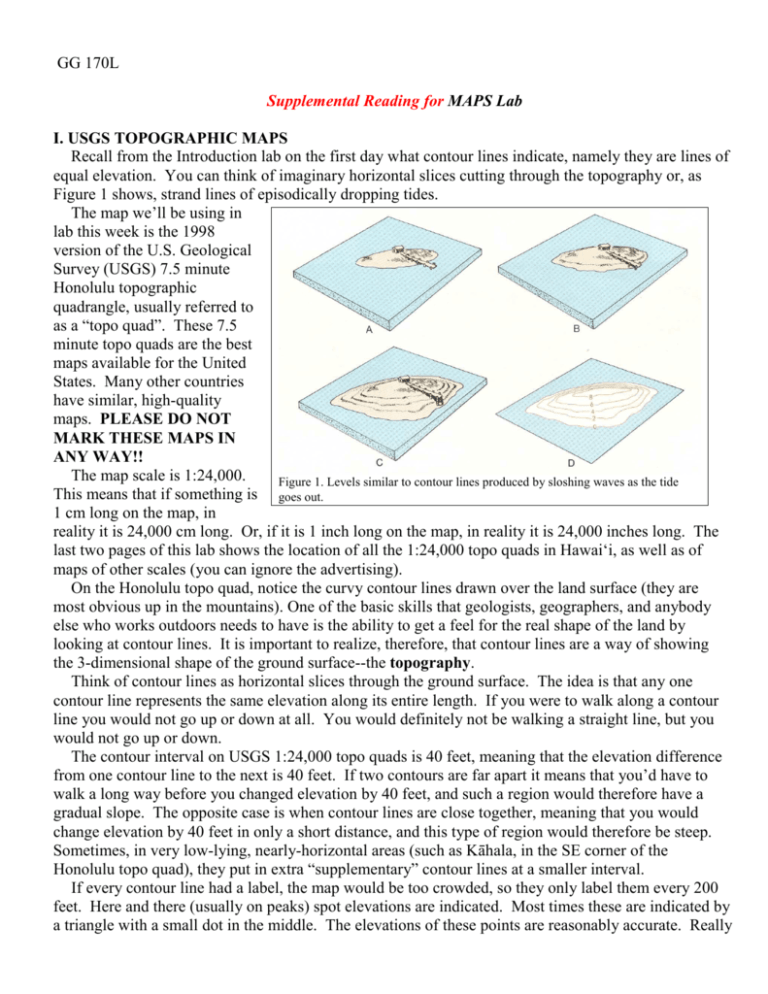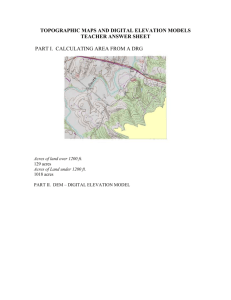GG 170L Supplemental Reading for MAPS Lab I. USGS
advertisement

GG 170L Supplemental Reading for MAPS Lab I. USGS TOPOGRAPHIC MAPS Recall from the Introduction lab on the first day what contour lines indicate, namely they are lines of equal elevation. You can think of imaginary horizontal slices cutting through the topography or, as Figure 1 shows, strand lines of episodically dropping tides. The map we’ll be using in lab this week is the 1998 version of the U.S. Geological Survey (USGS) 7.5 minute Honolulu topographic quadrangle, usually referred to as a “topo quad”. These 7.5 minute topo quads are the best maps available for the United States. Many other countries have similar, high-quality maps. PLEASE DO NOT MARK THESE MAPS IN ANY WAY!! The map scale is 1:24,000. Figure 1. Levels similar to contour lines produced by sloshing waves as the tide This means that if something is goes out. 1 cm long on the map, in reality it is 24,000 cm long. Or, if it is 1 inch long on the map, in reality it is 24,000 inches long. The last two pages of this lab shows the location of all the 1:24,000 topo quads in Hawai‘i, as well as of maps of other scales (you can ignore the advertising). On the Honolulu topo quad, notice the curvy contour lines drawn over the land surface (they are most obvious up in the mountains). One of the basic skills that geologists, geographers, and anybody else who works outdoors needs to have is the ability to get a feel for the real shape of the land by looking at contour lines. It is important to realize, therefore, that contour lines are a way of showing the 3-dimensional shape of the ground surface--the topography. Think of contour lines as horizontal slices through the ground surface. The idea is that any one contour line represents the same elevation along its entire length. If you were to walk along a contour line you would not go up or down at all. You would definitely not be walking a straight line, but you would not go up or down. The contour interval on USGS 1:24,000 topo quads is 40 feet, meaning that the elevation difference from one contour line to the next is 40 feet. If two contours are far apart it means that you’d have to walk a long way before you changed elevation by 40 feet, and such a region would therefore have a gradual slope. The opposite case is when contour lines are close together, meaning that you would change elevation by 40 feet in only a short distance, and this type of region would therefore be steep. Sometimes, in very low-lying, nearly-horizontal areas (such as Kāhala, in the SE corner of the Honolulu topo quad), they put in extra “supplementary” contour lines at a smaller interval. If every contour line had a label, the map would be too crowded, so they only label them every 200 feet. Here and there (usually on peaks) spot elevations are indicated. Most times these are indicated by a triangle with a small dot in the middle. The elevations of these points are reasonably accurate. Really accurate elevations are indicated by Benchmarks, shown with a little x, the letters BM, and the elevation. If you go that exact place you will see a brass plate set into the ground. The percent slope between two points is defined as the vertical change going from one to the other divided by the horizontal distance between them (sometimes called “rise over run”). Note that the units are not degrees, they are percent: 100*(∆elevation/∆distance). What is the percent slope between the water tank at the end of Mānoa Rd. and Kōnāhuanui? (Kōnāhuanui, by the way, is the highest point in the Ko‘olau mountains). Show your work: Except for road-builders, most folks think of slopes in degrees, not in %, and it is important to realize that they are not the same. For example, notice from Figure 2 that when the % slope is 100 (rise = run), the angle is 45°. What about when the vertical change (rise) is not equal to the horizontal change (run)? Can you still figure out the angle? Yes, but it requires a bit of trigonometry. Trigonometry sounds scary (and some of it is), but simple trigonometry is very useful, so we’ll take a detour here to show how you can use one tiny little bit of it to figure out angles. Figure 2: showing the relationship between rise and run Figure 3A shows the situation we are in: there are two locations, the water tank and the summit of Kōnāhuanui, and we want to calculate the slope, in degrees, of a line that connects them. Figure 3B shows how we can produce a right triangle (a triangle with one 90° angle) using the two known points. It is the slope of the dashed line that we are trying to calculate. The elevation difference between the two points is called the rise (you get this by subtracting the lower Figure 3: showing how to set up for calculating the slope in degrees between elevation from the upper two points elevation). The horizontal difference between the two points is called the run (you get this by measuring between the two points on the map). The angle θ is what you are trying to calculate. One of the more simple trigonometry formulas says that the tangent of θ equals the rise divided by the run. You would write it like this: tan θ = rise run But we don’t want to know the tangent of θ, we want to know θ itself. A related trigonometric formula says that the inverse tangent of the rise divided by the run is θ in degrees. You would write it like this: rise tan −1 =θ run For the rest of your life now, if you have two points and you know the elevation difference between them as well as the horizontal distance between them, you can calculate the slope (in degrees) of the line that would connect them. Who says GG101L isn’t practical?? The “Vertical Exaggeration” of a profile is defined as the length of some distance on the vertical scale divided by the length of the same distance on the horizontal scale. So if the length representing 500 ft on the vertical scale is 1 cm on the profile, and the length representing 500 ft on the horizontal scale is 0.5 cm on the profile, the vertical exaggeration is 1 cm/0.5 cm = 2. This would be stated as “2x vertical exaggeration”. People use vertical exaggeration for various reasons. Sometimes the topography is so flat that drawing with no vertical exaggeration is difficult. Other times they want to highlight peaks vs. valleys. Unfortunately, they often use vertical exaggeration but don’t say so. NASA is particularly guilty of this because most planets are actually quite flat. But they look much more dramatic if there are mountains and valleys, so they apply usually a lot of vertical exaggeration. You should always state what your vertical exaggeration is (even if there is none) so that people won’t get fooled when they look at your profile. The reasons behind the occasional mis-fit between maps of supposedly the same place often have to do with trying to fit parts of a non-flat Earth onto flat pieces of paper. The first thing that needs to be done is figure out what the actual shape of the Earth is (it is a lumpy oblate spheroid, not a perfect sphere). Map makers use mathematical models to define the Earth’s shape. The 1983 version uses the Clarke Spheroid, derived in 1886. Although it doesn’t say so, the 1998 version uses the GRS 80 Spheroid, derived in 1980. The radius of the Earth in the GRS 80 Spheroid is less than that in the Clarke 1886 Spheroid when measured at the equator, and greater when measured at the poles. Map makers also need to figure out the shape in the specific area of the map. In other words, the spheroid takes care of the non-spherical shape of the planet, but doesn’t account for the lumps. Importantly, Figure 5. Diagram showing the relationship between the lumpy Earth, the lumps are not the same everywhere. an Earth-centered spheroid that attempts to fit the entire planet, and a This is where the “Map Datum” comes in. local datum, which is a spheroid that is offset from the center of the The 1983 topo quad uses a datum called the Earth so that it fits one particular place well (at the expense of good fits to other places, of course). From: Understanding Map “Old Hawaiian Mean”, which does a good Projections, ESRI (2004). job of fitting Hawai‘i features, but is inconsistent with fitting other features in the USA. The 1998 map doesn’t use a datum, and instead tries to fit all of the Earth just with an Earth-centered spheroid. Figure 5 shows this set-up in a simplified manner. These spheroid and datum differences are what you see when you shift the 1983 map to line it up with the 1998 map. Probably the place where most people run into issues regarding spheroids and datums is when they use hand-held GPS units. These GPS units allow you to set which spheroid and datum you are using; you always want to make sure that it is the same as your map. Otherwise, the position it gives you won’t make sense relative to your map.







